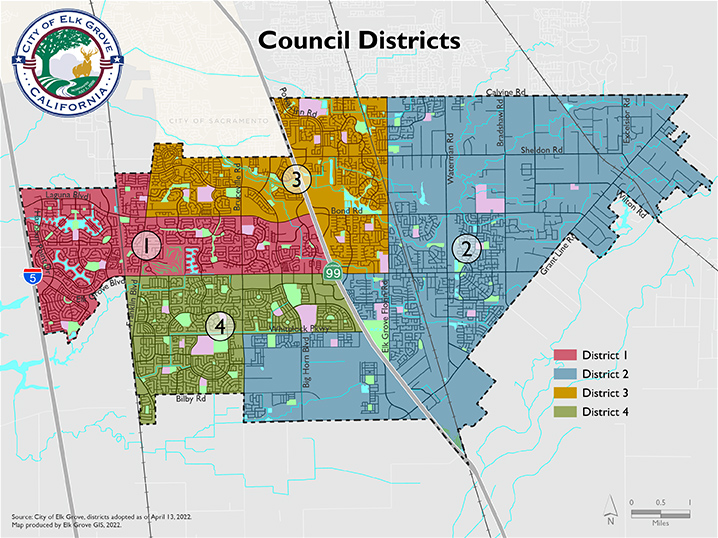At its meeting on August 28, 2019, the Elk Grove City Council took steps toward implementing a by-district election system for City Councilmembers. The first public hearings before the City Council to receive input on the composition of the election district maps were held on September 11, 2019 and September 25, 2019, public hearings to receive input on the content of maps were held October 9, 2019 and October 23, 2019. National Demographics Corporation, the City's retained demographer firm, provided an overview presentation on October 9, 2019 of demographics of the City and map alternatives, and draft maps were recommended to consider an ordinance approving a district map which was discussed at a public hearing on October 23, 2019. The City Council selected the current district map that has been utilized by the City since 2011 (approved by Resolution No. 2011-142) as the by-district map for the upcoming 2020 General Municipal Election.
On October 23, 2019, the public hearing under Item 9.5 was held to consider an ordinance to formally approve the current district map for by-district elections. The action would also confirm the sequence of elections and that Council Districts 1 and 3 would remain four year terms and would be up for election November 3, 2020 (including the office of the directly elected mayor which is a two year term), and Council Districts 2 and 4 would remain four year terms and would be up for election November 8, 2022 (including the office of the directly elected mayor which is a two year term) The ordinance was introduced at the conclusion of the public hearing by a 3-1-1 vote (Ayes: Ly, Detrick, Suen; Noes: Hume; Absent: Nguyen), the ordinance will return for second reading for adoption at the November 13, 2019 regular meeting.

Election District Systems
The City of Elk Grove currently has a “from-district” election method for its four Councilmembers, with a directly elected Mayor. Under this method, the Councilmembers must live within a designated district to be eligible to run for office for that district, with the voters of the entire city eligible to vote for each of the four Councilmembers, regardless of districts. The City’s Mayor is also elected directly by the voters of the entire city, but the Mayor may live in any district. Councilmembers serve for staggered four-year terms, and the Mayor serves a two-year term. Under the California Voting Rights Act (“CVRA”), the City’s from-district election method is considered “at-large” because all of the registered voters for the City of Elk Grove may vote for all positions on the City Council, including the Mayor.
On July 15, 2019, the City of Elk Grove received a letter dated July 10, 2019 from the law firm of Shenkman & Hughes. The letter was submitted on behalf of the firm’s clients and prospective plaintiffs the Southwest Voter Registration Education Project and Elk Grove resident Andres Ramos. By the letter, Mr. Shenkman contends that the City’s at-large, from-district election method results in racially polarized voting and vote dilution detrimental to the Latino voting community in Elk Grove. On behalf of his clients, Mr. Shenkman requests that the City of Elk Grove transition to a “by-district” or “district-based” election method. Under a district-based election method, the city would be divided into certain election districts, with only the voters of that district electing the councilmember for the district.
Elk Grove is one of many cities, special districts, and school districts throughout the state to receive a letter from a law firm alleging that the method of electing city council officials through an at large system as opposed to a district-based system violates the CVRA. The sending of such a letter is required by the CVRA prior to a plaintiff filing a lawsuit. The letter gives the City the opportunity to voluntarily transition to district-based elections to avoid a lawsuit.
There has been no finding that the City of Elk Grove has violated the CVRA or any other law protecting residents’ rights to vote. However, rather than engage in expensive litigation over this issue, the City Council has decided to take steps to transition to a district-based election approach. If it fails to do so, it may face litigation potentially costing the City millions of dollars in legal fees. The proposed district-based election system in Elk Grove would still result in the Mayor being directly elected, meaning that all registered voters of the City would be eligible to vote for the Mayor regardless of districts.
Project Status and Next Steps
In response to the letter requesting that the City transition to a district-based election system, the City passed a resolution of intent on August 28, 2019. This action prevents the plaintiff from filing a lawsuit for at least 90 days from the passage of the resolution. The City has these 90 days to hold hearings and pass an ordinance transitioning to a by-district approach in order to avoid exposure to the lawsuit. (Elec. Code § 10010(e)(3)(A), (B).) This 90-day period may be extended by an additional 90 days by written agreement between the prospective plaintiff and the city. (Elec. Code § 10010(e)(3)(C).)
During the 90-day period (or any agreed-upon extension), the City must hold at least two public hearings over a 30-day period to invite input concerning the composition of the proposed district maps, as well as at least two additional hearings over a 45-day period to provide input after the proposed maps are drawn. The city may then adopt an ordinance selecting a district map. (Elec. Code § 10010(a)(1), (2).) The City may adopt such ordinance without submitting the ordinance to the voters for approval in order to meet the timelines provided by the CVRA. (Gov. Code § 34886.)
The first four public hearings were held on September 11, 2019, September 25, 2019, October 9, 2019, and October 23, 2019. The City Council selected the current district map that has been utilized by the City since 2011 (approved by Resolution No. 2011-142) as the by-district map for the upcoming 2020 General Municipal Election. A separate public hearing was held on October 23, 2019 under Item 9.5 to consider an ordinance to approve the district map. The action would also confirm the sequence of elections and that Council Districts 1 and 3 would remain four year terms and would be up for election November 3, 2020 (including the office of the directly elected mayor which is a two year term), and Council Districts 2 and 4 would remain four year terms and would be up for election November 8, 2022 (including the office of the directly elected mayor which is a two year term) The ordinance was introduced at the conclusion of the public hearing by a 3-1-1 vote (Ayes: Ly, Detrick, Suen; Noes: Hume; Absent: Nguyen), the ordinance will return for second reading for adoption at the November 13, 2019 regular meeting.
Frequently Asked Questions
What is the California Voting Rights Act (CVRA)?
The California Voting Rights Act of 2001 (“CVRA”) is set forth at Elections Code sections 14025 to 14032. The CVRA defines “at-large” and “district based” election methods. An “at-large election method” includes an election method by which the voters of the entire city vote for members of the city council, regardless of where they reside, as well as an election method under which candidates must reside in certain districts and the voters of the entire city elect the councilmembers, i.e. a “from-district” method. (Elec. Code § 14026.) The CVRA uses the term “district-based elections” and defines that term in substantially the same manner as “by-district” elections, i.e., the candidate is elected only by the voters residing within the election district. (Elec. Code § 14026.) Even though the City of Elk Grove has districts, because the City uses a “from-district” election method, the City’s election method is considered to be an “at-large” method of election under the CVRA.
The CVRA prohibits “racially polarized voting.” (Elec. Code §§ 14027, 14028.) Racially polarized voting means that there is a difference between the choice of candidates preferred by voters of a racial minority class, and the choice of candidates that are preferred by voters in the rest of the electorate, so as to dilute the vote of the racial minority class of voters. (Elec. Code §§ 14026, 14028.) In other words, the CVRA prohibits an at-large election method that impairs the ability of a racial minority class from influencing the outcome of an election due to dilution of their vote by nonracial minority voters. This is typically proven or disproven by way of detailed statistical and demographic analyses of voting behavior. Proving a violation of the CVRA does not require proof of an intent to discriminate. (Elec. Code § 14028.)
What does it cost to go to district-based elections?
Demographer services to assist with the public hearing processes to transition to a by-district system of election were authorized in an amount not to exceed $40,000 on August 28, 2019 by Resolution No. 2019-192.
If the City transitions to a by-district method of election, staff anticipates future election costs will increase by an estimated $42,500, for a total estimated election cost for November 2020 of $181,000, based on the current registered voter count of 95,000.
If the City Council ultimately adopts an ordinance moving to a by-district method of election, the City may also be liable for statutory costs to the prospective plaintiffs of up to an additional $30,000 (as adjusted by inflation). The matter of those costs is dependent upon the City Council’s future action on the decision whether to transition to a by-district election method following the public hearing process.

